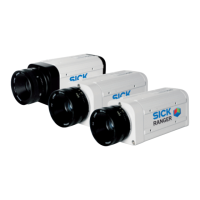Reference Manual Chapter 5
Ranger E/D
©SICK AG • Advanced Industrial Sensors • www.sick.com • All rights reserved 53
Configuring Ranger E and D
profile, the resulting profile appears to have two distinct levels, or have profile points that
appear at more or less random positions, the morphological filters can help the situation.
There are two basic binary morphology filters, shrink (erode) and expand (dilate), and both
those are implemented.
Morphological filters are applied to each pixel in the image, and the result in each pixel is a
function of the pixels within a defined region around that pixel. The morphological filters in
Ranger work on single columns of 3-5 vertically oriented pixels, i.e. each pixel are proc-
essed together with neighbors above and below up to 2 rows away.
If the profiling algorithms use multiple thresholds each thresholded image is processed
independently, but using the same filter settings.
Using the morphological filters with size 3 gives no decrease in algorithm speed, but
increasing the filter size might give a small increase in minimum possible cycle time.
If both morphological and median filter is used, the morphological filter is applied before
the median filter.
Figure 5.16 – Applying a morphological filter to one column of the sensor image
In a shrinking morphological filter of size Nx1 pixels the operation is defined as a Boolean
AND of the pixels within the region. That is, if all pixels within the region are 1 the result is
1, otherwise 0.
Consider the binary images in the figure above. In the first noisy example, the noise peak
is removed by the shrink filter, but in the second example the result is only improved by
the expand filter.
In an expanding morphological filter of size Nx1 pixels the operation is defined as a Boo-
lean OR of the pixels within the region. That is, if any pixel within the region is 1 the result
is 1, otherwise 0.

